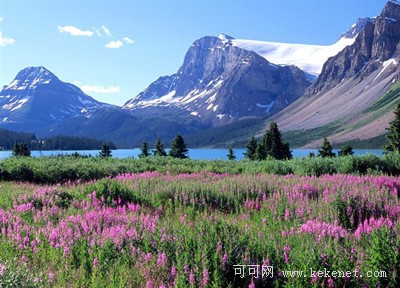(单词翻译:单击)
听力原文
在上一期的节目中,咱们大致了解了板块构造说。这个学说能够说服咱们对于落基山的来源吗?嗯,好像仍有很多的谜团解不开,那么还是得借助于考古的发现,考古中最重要的就是化石。除了菊石化石,还有什么其他化石吗?看看啰!
...remained. How did the collision of two tectonic plates at the western edge of North America cause the rise of the Rockies 500 to 1,000 miles inland?
Mountain ranges that formed on the margins of continents are pretty easy to explain, or where continents have collided. When India slams into Asia, we get the Himalayas. Where Oceanic crust dives beneath the continental margin in the northwest, the Cascades or in South America the Andes Mountains, but these mountains here, in the middle of the continent, are much harder to explain. And they've been / an enigma for decades.
Only recently, geologists have come up with a plausible theory. They suspect the Rockies formed along a line where the crust is very fragile.
What happens when the continent gets compressed, especially if there is a weak zone, or a zone that's prone to buckling? It rises. That's what's brought this granite to the surface.
Geologists now understood how the Rockies rose. And they had a date for when it happened. But what were these early mountains like? How did they compare to the mountains of today? On a site in the Rockies 70 miles northwest of Denver, geologists find a clue.
Mountains that we see here today aren't the mountains that were around millions of years ago. They are always evolving. Rivers are shifting. Peaks are shifting. It's a very dynamic process. Someone says as if mountains are alive themselves.
Miller sets out to estimate the height of the early mountains. But how can you measure something that is no longer there? Once more, fossils provide the evidence he is looking for.
What's amazing about collecting fossils is that you are really the first person to see this when you crack open a rock. It's first time it sees light again after 16 million years.
Miller has uncovered a 16-million-year-old fossilized leaf. It's from a tree that grew here just 10 million years after the Rockies began to form. And intriguingly, this leaf holds a clue to the height of these early mountains, or more precisely, it's the edges of the leaf, known as leaf margins. Botanists know that in colder temperatures the margins tend to have more teeth than leaves that grow in warmer areas.
小编有约:今天小编考考大家的发散性思维,"Mountains that we see here today aren't the mountains that were around millions of years ago. They are always evolving. Rivers are shifting. Peaks are shifting. It's a very dynamic process. Someone says as if mountains are alive themselves. " 你喜欢山吗?你有时间在山里走一走,呼吸山里的空气吗?对于最后两句你是怎样理解的?
对这段话Daisy有特殊的体会。从小生活在山边的我,对于山的变化是很敏感的。山也是有呼吸的。走在山里,那种静谧与安详的环境,人在不知不觉中就感到安定。偶尔的鸟叫,和蝴蝶的飞舞,会让人感到各种各样的生物都绚烂地活在这个世界,大自然的一切都那样的美好。所以请爱护大自然吧。这是Daisy的感想,你的呢?
参考译文
......但仍然保持着神秘。位于北美西部边缘的两个构造板块之间的碰撞,如何引起内陆500至1000英里的落基山脉的崛起?
大陆的边缘所形成的山脉,或者大陆相撞所形成的,都是很容易解释的。就像是印度大陆与亚洲大陆的相撞,便形成了喜马拉雅山。然而,海洋地壳不断的潜入大陆边缘的下方,在北美西北部形成了瀑布以及南美洲形成了安第斯山脉。这儿的山脉却都在内陆,这可让人怎么解释。几十年来,这山脉怎么来的一直是个未解之谜。
直到最近,地质学家们想出了一个貌似合理的理论。他们怀疑,落基山脉是沿着一条很脆弱的地壳形成的。
如果把陆地压缩会发生什么,尤其是在一个脆弱的区域,或者这个区域很容易屈曲?也许它会上升。这就是为什么花岗岩会来到表面的原因。
地质学家现在理解了落基山脉是如何上升,也估算出落基山脉诞生之日。在丹佛西北70英里处,地质学家找到了线索。
我们今天在这里看到的山,与大约百万年前的山是不一样的。他们在不断的变化,河流永不停歇的流动,山峰也在转。整个都在动。因此有人说,山本身就活着。
米勒开始估算原始落基山的高度。但是怎么能测量根本就不存在的东西?化石又一次给他提供了证据。
当你真正第一个打开岩石,你会对岩石中的化石感到惊讶。这些化石是经过了16亿年以后首次重见光明。
米勒已经发现了一个16亿年的叶子化石。大约在10亿年前,它从这儿的一棵树上掉下来,而此时落基山刚刚形成。有趣的是,这片叶子可以让我们知道早期洛基山的高度,或者确切地说,是这片叶子的叶片边缘,也被称为叶缘给我们提供的线索。植物学家知道,低温下的叶子与温暖环境中的叶子相比,它们的叶缘往往会有更多的齿状形周边。
重点讲解
注释:① ranges n. 量程,范围;山脉(range的复数)
v. 延伸(range的第三人称单数);排列;把…分类
例句:
1. The tariff at the hotel ranges from 20 dollars to 50 dollars a day for a single room.
旅馆的单人房间的价钱每天从20美元到50美元不等。
2. The frontier ranges from the northern hills to the southern coast.
边界从北部山地一直延伸到南部海岸。
② slam v. 砰地关上, 猛放, 猛烈攻击 n. 砰然声, 猛烈抨击
例句:
1. Please don't slam the door.
请不要使劲关门。
2. He slammed the papers down on my desk and angrily walked out.
他把文件使劲扔在我的桌子上便怒气冲冲地走了出去。
③ plausible adj. 貌似可信的,花言巧语的;貌似真实的,貌似有理的
例句:
1. She could find no plausible explanation for its disappearance.
她无法解释清楚何以不翼而飞。
2. He trotted out a most plausible story, but most of us were inclined to doubt the truth of it.
他提出了一个听起来很有道理的说法,但我们大多数人对此都持怀疑态度。
句子讲解:
1. Where Oceanic crust dives beneath the continental margin in the northwest, the Cascades or in South America the Andes Mountains, but these mountains here, in the middle of the continent, are much harder to explain.
【结构简析】这句话是where引导的地点状语从句,这句话中间的插入语很多,但我们看主干句,这句话是"these mountains are much harder to explain. " Daisy建议大家如果看不懂句子,抓主干会让我们更清晰的分析句子。
【参考译文】然而,海洋地壳不断的潜入大陆边缘的下方,在北美西北部形成了瀑布以及南美洲形成了安第斯山脉。这儿的山脉却都在内陆,这可让人怎么解释。
2. What's amazing about collecting fossils is that you are really the first person to see this when you crack open a rock.
【结构简析】这句的主语是what引导的主语从句,谓语部分是that引导的表语从句,表语从句中还还有个when引导的状语从句。
【参考译文】当你真正第一个打开岩石,你会对岩石中的化石感到惊讶。


